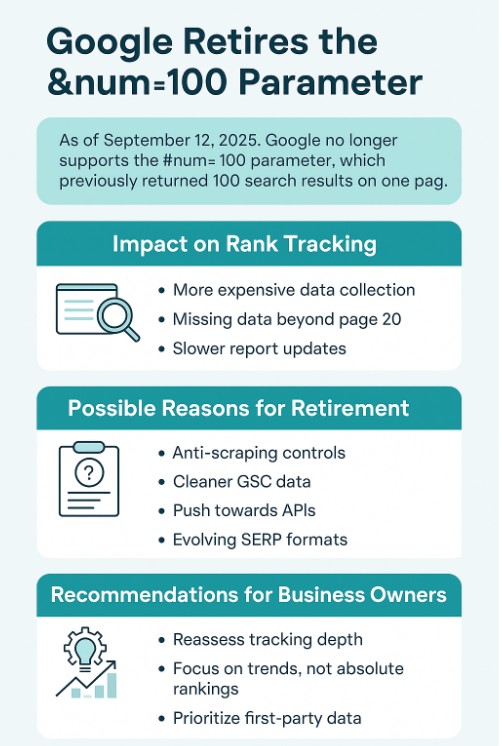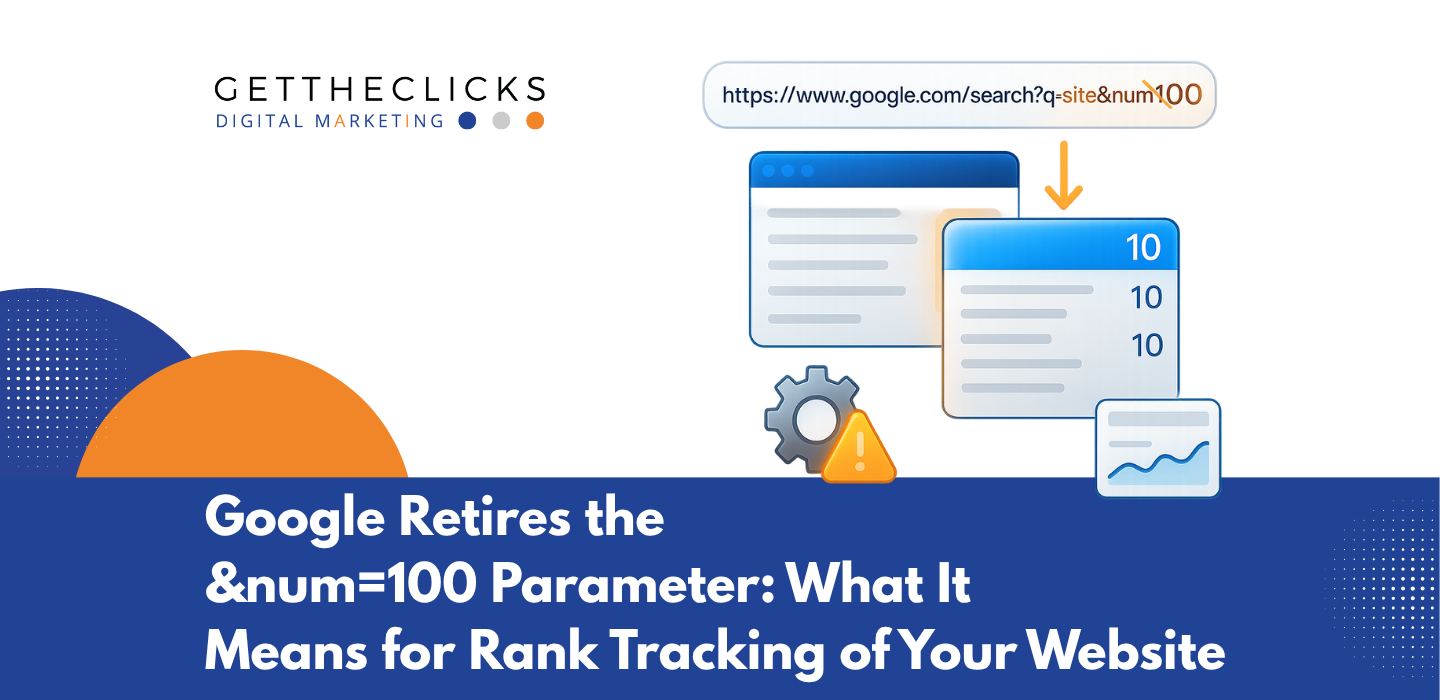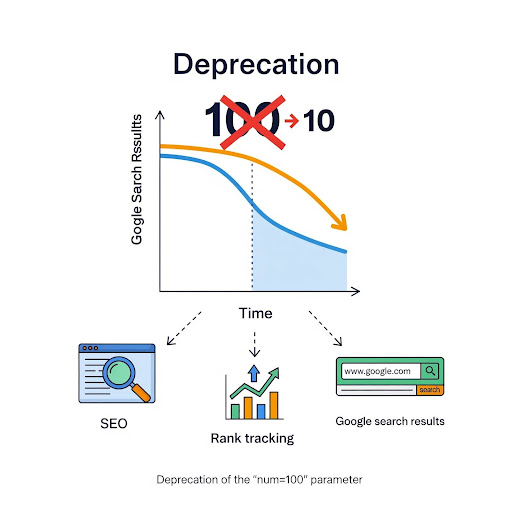TL/DR
- Google Retires &num=100 Parameter: As of September 12, 2025, Google no longer supports the &num=100 URL parameter, which previously allowed users to view the top 100 search results on a single page. Search requests now default to approximately 10 results per page.
- Impact on SEO and Rank Tracking: This change significantly affects rank tracking tools, making data collection more expensive, potentially leading to missing data for keywords ranking beyond page 20, and slowing down report updates.
- Impact on Google Search Console (GSC): SEOs may observe drops in impressions and seemingly better average positions in GSC, but this is due to the disappearance of bot-driven impressions from &num=100 requests, not actual performance changes. Traffic, clicks, and conversions remain largely the same.
- Possible Reasons for Retirement: Theories include anti-scraping controls, cleaner GSC data, a push towards official APIs, and evolving SERP formats (continuous scroll, AI overviews). The author also speculates it’s a move to limit AI systems’ ability to scrape extensive search data.
- Recommendations for Business Owners: Reassess tracking depth, focus on trends rather than absolute rankings, prioritize first-party data (organic sessions, CTR, conversions), annotate reports to mark September 2025 as a data break, and consult with marketing agencies on their new tracking approaches.
- The Bigger Picture: This change emphasizes the importance of “page one” visibility in SEO. While the loss of deeper rank tracking data is a setback for forecasting future success, it signals a new era of customer acquisition requiring a holistic marketing approach and new KPIs.

Introduction
As if 0-Click search (Google’s AI Overviews) hasn’t affected your website traffic enough, now Google threw another doozy at all of us. On September 12, 2025, Google quietly flipped a switch that sent ripples across the SEO industry. A long-standing URL parameter — &num=100, which instructed Google to return the top 100 results in a single search request — no longer works as expected.
To casual users, this change may seem trivial. But to any business owner who pays attention to their keyword rankings, it’s a big deal. The loss of &num=100 affects how data is gathered, rankings are reported, and performance is interpreted on many tools available to anyone. This even includes Google’s own Search Console (GSC).
What Happened
By appending &num=100 to a Google search URL once, it was possible to return the top 100 organic results in one page. This was the backbone of many rank tracking tools, enabling quick capture of positions 1–100.
Now, as of September 2025, that’s gone. Google confirmed it no longer supports the parameter and search requests default back to roughly 10 results per page.
Why Did Google Retire It
Google hasn’t given a clear explanation but multiple theories are circulating:
- Anti-scraping controls — stopping bulk data collection.
- Cleaner Google Search Console (GSC) data — removing bot-driven impressions.
- Push toward official APIs — forcing developers to use structured endpoints.
- Evolving SERP formats — continuous scroll and AI overviews make “100 results per page” outdated.
I Believe There May Be Another Reason
AI systems like ChatGPT present a real threat to Google’s stranglehold on the search industry. This is the first time in two decades that Google’s search monopoly can be undone. Thus I believe Google removed the ability for an API engine (the mechanism by which an AI can pull information from the web) to scrape all of the data from its top 100 results, because AIs like ChatGPT and Claude were doing a better job providing answers than Google itself. With Google’s change, the AIs can now only scrape the top 20 results instead of the top 100. Naturally this will vastly limit an AIs ability to provide detailed information.
Impact on Rank Tracking
- More expensive: Tools need 10x more requests to capture top 100 results.
- Missing data: Keywords ranking beyond page 20 often just disappear.
- Slower updates: Rank tracking reports refresh less often due to the increased load.
Our Own Website Rank Report
Take a look at the rank report of our own website. If you didn’t know that Google had done this, you’d think the rankings of many of your keywords had fallen off a cliff.

Fact is, nothing has changed. Our tracking software simply can’t reach those keywords anymore because Google shut off the spigot to scan those higher level rankings.
Impact on Google Search Console
SEOs have reported big drops in impressions and better-looking average positions. But this isn’t real performance change. It’s measurement distortion:
- Bot-driven impressions from &num=100 requests disappeared.
- Removing those low-ranking impressions skews averages up.
- Traffic, clicks and conversions remain mostly the same.
Treat GSC impression and position metrics post-September 2025 with caution.## What a Business Owner Who Tracks This Should Do
- Reassess tracking depth — Do you really need positions 50–100?
- Focus on trends, not absolutes — Directional changes matter more than “rank #68.”
- Lean on first-party data — Organic sessions, CTR, conversions, engagement.
- Annotate reports — Flag September 2025 as a data break in dashboards.
- Ask your Marketing Agency — How are they handling deeper SERP tracking now?
The Bigger Picture
Google’s move is a reminder: SEO visibility is about page one. As deeper ranking data becomes less accessible, business owners need to focus more on outcomes — traffic, conversions, revenue, etc. and business results
One Counter Point I’d Like to Make – Trend Tracking is Over & That Sucks.
While we can all agree that a keyword ranking #75, or #30 isn’t going to provide any tangible revenues, when you saw a keyword climbing higher in ranks every month, it was an indicator of things moving in the right direction. Rank tracking between ranks 20-100 allowed a business owner to forecast future business success. Personally, I find that a very valuable indicator to consider because you are seeing a keyword you care about, moving up in the world, and that provides comfort and reassurance that everything is on track.
None of this is possible any longer. I admit, I’m being a bit dramatic here but you might as well cut the search off at 20 results and tell a user no more relevant information exists beyond that point. Tell that to the guys ranking #21.
Moving Forward
The end of &num=100 is more than a technical deprecation; it’s a signal. It’s a signal of things to come.
Page one visibility continues to be where the fight is. The best way to gauge your future success is to take your historically best performing keywords and check those rankings yourself on Google in Incognito mode.
In the reports, your website rankings will likely have bounced all over the place. Give your marketing agency a bit of grace for a few months while the dust settles before you serve their head on a silver platter. If history is any indication, I’d tell you to ride it out for at least 90-120 days. Remember the days of one digital marketing approach? I’d argue those days are over. With daily increases of AI Overviews, more and more 0-Click searches and now the end of keyword trend tracking making long-term planning harder, it feels like the walls are caving in, BUT what it really means is a new era of customer acquisition has begun. It’s an era that requires a holistic approach to marketing and new KPIs to measure against.
More on this in another post I’m working on.
September 2025 will be the month you changed the way you measure success online forever.




